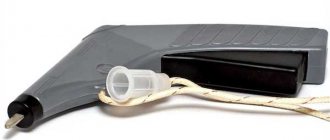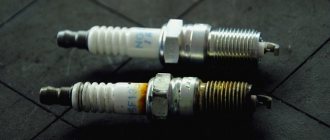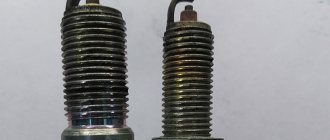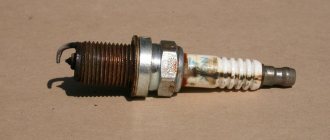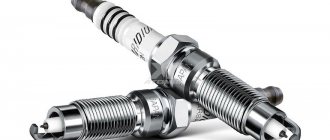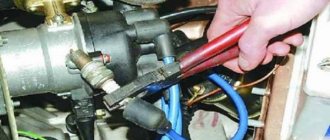Every driver knows that the condition of the spark plugs affects the performance of the car's engine. You need to know everything about spark plugs (color of coating, gaps, when to change them and much other information).
During operation, spark plugs are subject to several types of loads:
- Electrical.
- Thermal.
- Mechanical.
- Chemical.
Thermal loads. The spark plugs are installed in such a way that the working part is located in the combustion chamber, and the contact part is in the engine compartment. The temperature of the gases in the combustion chamber can reach 900°C, and in the engine compartment – up to 150°C.
Thermal stress and deformation are promoted by different temperatures of the spark plugs due to uneven heating in different sections, which differ by hundreds of degrees.
Mechanical loads. In addition to the thermal load on the spark plugs, a vibration load is added due to different pressures in the engine cylinder, which at the inlet is below 50 kgf/cm², and during combustion is much higher.
Chemical loads. During combustion, a lot of chemically active substances are formed, which cause oxidation of all materials, because the operating temperature of the electrodes reaches 900°C.
Electrical loads. During sparking, the spark plug insulator is exposed to a high voltage pulse, which sometimes reaches 20-25 kV. In some ignition systems, the voltage can be created much higher, but the breakdown voltage of the spark gap limits it.
How spark plugs work
Spark plug diagram
Spark plug gap. What should it be and what does it affect?
Despite the simplicity of the structure of spark plugs, they need to be worked and handled correctly.
They need to be cleaned correctly, selected and replaced correctly. However, even new options can sometimes cause problems - the car may run unevenly, sometimes there are jerks (shocks) when accelerating, as well as slight detonation. Many people immediately begin to look for the cause in the ignition system - of course, the spark plugs are new! However, the culprit may be the gap between the electrodes; just correct it and the engine will simply “sing”... CONTENTS OF THE ARTICLE
First, a little definition.
The spark plug gap is the distance between the upper and lower electrodes, necessary for optimal operation and ignition of the fuel mixture. If this distance differs from the recommended standards, the engine will not run smoothly, and either twitching or detonation similar to “triple” of your unit is possible.
In simple words, if the gap is different from the norm, set this way from the factory or by the seller, then you can shovel at least half of the motor, but you won’t find the reason. This is especially noticeable on carburetor systems. BUT first, I suggest starting with the device and operating principle.
How does ignition work in a cylinder?
If we talk about spark plugs, then this is like the last link in the ignition system, which is in direct contact with the air-fuel mixture. It is this element that sets it on fire, and does it either effectively and as laid down in the technical regulations, or ineffectively for a number of reasons (by the way, wear is often to blame).
After the fuel mixture (gasoline and air) has been supplied to the cylinders, the piston begins to go up and compress it, thereby increasing pressure.
At the peak or, as is commonly called, the “top point,” the ECU gives an order and this composition ignites. Moreover, it is ignited by the spark plug - a spark runs between the electrodes, which is the catalyst.
However, ignition may not occur, I am not currently considering options with a faulty ignition system, it’s just that the gap is set incorrectly. Thus, “missing” may occur (that is, the fuel mixture does not ignite), which will cause your engine to operate with low efficiency, and sometimes it will not start at all (for example, in the morning in winter). But why does this happen?
Frequency of replacement of spark plugs
Each car enthusiast has his own approach to this issue: some change spark plugs along with an oil change, while others do not change them at all.
It is impossible to unambiguously give a figure for the frequency of replacement because it directly depends on the material of the spark plugs :
- Copper/nickel spark plugs have a standard service life of up to 30 thousand km. , their cost is quite consistent with their service life, the price of one such candle will be around 250 rubles. I would change such spark plugs along with an oil change.
- Platinum spark plugs (sprayed onto the electrode) are in second place in terms of service life, applicability and price tag. The duration of trouble-free operation of spark ignition is twice as long, that is, about 60 thousand km. In addition, the formation of soot will be significantly less, which has an even more favorable effect on the ignition of the air-fuel mixture.
- Iridium spark plugs significantly improve thermal performance. These spark plugs provide an uninterrupted spark at the highest temperatures. The service life will be more than 100 thousand km , but the price will be much higher than the first two.
But you shouldn’t fall for advertising; even if you buy iridium spark plugs, no one guarantees you 100 thousand km. mileage
The frequency of replacing spark plugs largely depends on the condition of the engine and fuel , and in general, your car. If the car “eats oil”, then the spark plugs will fail much earlier than the declared service life.
The influence of the correct clearance on engine performance
The gap is a really important parameter. It can either be big or too small.
Small gap
If small values are set between the electrodes, then misfires will occur in the ignition system. The thing is that the spark that forms between the electrodes, which are as close to each other as possible, is not enough to ignite the fuel mixture. The spark, although strong, is not sufficient. This is why many cars will really jerk when driving and not develop enough speed. The carburetors may have flooded spark plugs, which will only cause problems – it will generally cause problems. The gap needs to be increased!
How much is a small gap? If we talk about size, it is approximately from 0.1 to 0.4 mm. We definitely check the candles after purchase, I’ll give practical recommendations below, but for now let’s talk about long distances.
Big gap
You know, many manufacturers set the normal distance between the electrodes in advance. But over time, it can increase on its own.
It's all about spark plug wear, which manifests itself with high mileage - this is natural. After all, the electrodes are made of metal, which, under the influence of temperature and constant electrical discharges, begins to slowly burn out. Both the upper one, which resembles the letter “G”, and the lower one suffer. The top one becomes thin, instead of a rectangular shape, it begins to be rounded, because the sides burn out. The bottom one just sags down.
Due to this distance, the spark that passes between the contacts weakens. And significantly! It may also not be enough to ignite the fuel.
Often, because of this, the insulator of the lower contact is pierced; the whole point is that the spark tries to find the shortest path between the electrodes.
In winter, there is a high probability that the car simply will not start.
Another important aspect is that deposits in the form of soot may more often appear on distant electrodes; the spark “suffers” from the long distance, and so does deposits! It may not pass at all. Therefore, it is important after a certain mileage, with our fuel it can be already 15,000 km, to unscrew the spark plugs if necessary, change them, or clean them.
Large distance - from 1.3 mm and above.
Normal gap, what you need to focus on
We have very specific limits. Bottom from 0.4 mm (and everything below), top from 1.3 mm (and everything above). So what is considered the normal size for your car?
You know, there are differences here too, they are connected primarily with the car’s ignition system, which can be roughly divided into three types:
1) For carburetor type, with distributor - normal clearance is from 0.5 to 0.6 mm
2) For carburetor type, with electronic ignition – 0.7 – 0.8 mm
3) Injector – 1 – 1.3 mm
Why such difference? - you ask. The answer is simple - it's a matter of the ignition system and electrical circuit. The carburetor has the lowest voltage, so the spark will be weaker, and therefore the gap should be smaller. But the injector has the strongest energy system, so here the gap is increased, normal is considered to be 1 mm, and on many foreign cars it is 1.1 mm.
How to choose spark plugs
From the above, it becomes clear that the quality of spark plugs directly depends on their price. Undoubtedly, iridium spark plugs are considered the best choice. But if you are a supporter of the idea that it is better to buy a cheaper spare part, but change it more often, then nickel spark plugs are quite suitable for you.
The main parameter in your choice will be the recommendations of your car manufacturer. I have already described in detail how to choose the right spare part yourself in this article. Excellent manufacturers are: Bosch, Beru, Finwhale, Valeo. You should not buy candles from a dubious company.
Also, when choosing spark plugs, pay attention to the number of electrodes. Multi-electrode spark plugs performed well.
multi-electrode spark plugs
Another very important parameter is the gap between the spark plug electrodes. When installing, be sure to check the gap on the spark plug. This number must comply with the vehicle manufacturer's recommendations. When installing spark plugs with a large gap, there is a risk of failure of the ignition coil. Typically, on nickel spark plugs this parameter should be in the range of 1-1.3 mm. This parameter should not be neglected; the nature of the work and service life directly depend on the gap of the spark plug.
Subscribe to our YandexZen, we have collected the most interesting reviews of family cars for you there!
4 301
How to check and how to set it
The process is not as complicated as it seems at first glance. To begin with, we simply unscrew the spark plugs, then look for damage; if there is none, then you can first clean it, then check the gap.
Of course, the gap can be measured with conventional measuring instruments, just a ruler. However, it is very difficult to determine 0.5 or 0.7 mm by sight! Therefore, now in stores you can buy so-called sets of “feelers” or special keys for checking the gap.
The probes are similar to metal curved letters “G”, with different sizes; we simply place them between the electrodes and determine the gap with an accuracy of 97%. If it is larger, for example on an injector than 1.1 mm, then the contacts are brought closer to each other, you can simply tap with the handle of a screwdriver. If it’s too close, then we move them apart from each other, again checking with a probe.
Watch my video about the gap.
Modern technologies
What I want to say in conclusion, many will think “come on,” why should I bother with some distance between the electrodes! Guys, very wrong thoughts.
Firstly , you can save on fuel, studies show up to 5 - 7%
Secondly , smooth engine operation is the key to driving safety.
Third , the correct gap between the spark plugs increases their service life; there is no chance that the insulator will break through (with an increased distance).
I would like to note that some companies, on the contrary, increase the number of contacts (electrodes), strengthen the coils and the ignition system, all so that the mixture is ignited better.
There are also more modern technologies now, which I think will soon replace them - such as plasma candles.
They have no electrodes at all, and the fuel is ignited by a beam of plasma that is generated by electricity. As they write, the production is now undergoing tests and they say that the combustion efficiency of the fuel mixture is increasing, which means a little more power, a little more economy and environmental friendliness of the engine.
And that’s all for me, read our AUTOBLOG, it will be interesting.
(
39 votes, average: 4.00 out of 5)
The importance of quality spark plugs
The resulting spark in the combustion chamber “ignites” the fuel-air mixture, starting a workflow that allows the engine to function fully. Thanks to spark plugs, the power unit comes to life, without them remaining a useless piece of metal.
The slightest defect in the spark plugs can have a detrimental effect on the performance of the engine, even to the point of failure. Therefore, if you suspect even minimal problems with the spark plugs, it is necessary to eliminate them without waiting for fatal consequences.
When a part fails, the load on the ignition coil increases, quickly ending in its failure. At the same time, the price of a spark plug is disproportionately small compared to the price tag for a coil. Driving with an engine with faulty spark plugs is characterized by instability at idle and increased driver nervousness.
A well-tuned power unit operates smoothly and softly at 1000 rpm. Faulty spark plugs cause jumps in the tachometer readings, and at the same time the engine may vibrate or make an unpleasant grinding noise. Therefore, even a person who is far from car hardware can determine the cause of unstable engine operation, due to the ignition system.
Condition of spark plugs by appearance
Every 30-90 thousand kilometers, spark plugs must be replaced, depending on the intensity and conditions of engine operation and the type of installed spark plugs.
Replacing spark plugs ahead of schedule
If malfunctions begin to appear during engine operation, then it is necessary to replace the spark plugs. According to the regulations, they should last up to 30-90 thousand km, but practice has shown that after 15 thousand km the spark plugs may require replacement.
This is interesting: The emergence of chip tuning
The reduction in spark plug work is influenced by the quality of fuel, potholes on the roads, the duration of the engine idling and many other factors.
Spark plug faults and their symptoms
Engine operation should be uniform, both at idle and under load, and the sound during operation should be “like a clock.” If the engine starts with difficulty, fuel consumption begins to increase, speed is lost under load, noise or vibration appears - these are all symptoms of faulty spark plugs. To prevent a complete engine stop, it is necessary to constantly monitor the condition of the spark plugs.
How are spark plugs checked?
As soon as the spark plugs become dirty or fail, the engine begins to fluctuate, run intermittently and give increased vibration. Spark plugs become dirty or fail one at a time, so you need to find a dirty spark plug to replace it. There are several ways to do this:
- Check the spark plugs yourself.
- Use a spark plug tester.
Ignition system design
For many years, starting from the invention of the internal combustion engine, no fundamental innovations were introduced in the structure and functionality of candles. The main task was and remains the conversion of electrical energy with the creation of a high-voltage arc, leading to ignition of the fuel mixture.
The combustion chamber, where the engine is “revitalized,” includes:
- Ceramic insulator. It ensures stable and uninterrupted spark formation.
- A metal casing that allows the structure to be carefully installed into the engine.
- Electrodes that supply and convert electric current into an arc.
- A contact head having a threaded connection.
The “heart” of the ignition system is two electrodes. The current from the generator flows through high-voltage wires from the head directly to the spark plugs. The technological process has remained unchanged over the years of the internal combustion engine's existence.
Signs of faulty spark plugs
If the spark plugs do not work correctly, the power unit begins to function with errors.
. It does not perform the necessary functions, and urgent diagnostics and specialist help are required to restore its functionality:
- Starting the engine is associated with visible, serious difficulties. This is an unconditional signal to the owner to check engine errors and replace the spark plugs.
- The nature of the engine's operation changes. It jerks, twitches, the car loses torque, and the power drops.
- Problems with faulty spark plugs lead to a sharp increase in gasoline consumption. The ignition does not work constantly, skipping periods. As a result, the mixture does not burn completely. Exhaust gas analysis shows a high proportion of CO.
- No matter how much pressure is applied to the gas pedal, the engine cannot gain the required speed and operates with low power.
By responding promptly to signs of possible spark plug failure, you can avoid catastrophic engine problems in the future.
Identifying spark plug faults
The problem is visually detected by the “naked eye” even by a person far from the car. The first and determining indicator of a faulty spark plug is uneven operation of the car - it constantly stalls.
The malfunction prevents the gasoline-air mixture inside the cylinder from igniting. Instead of combustion, the fuel flows into the catalyst. This defect can be smelled by the nose - the aroma of gasoline is very sensitive.
Gasoline engines must maintain a temperature inside the cylinders of about 400-500 degrees Celsius for efficient fuel combustion. Only after reaching a “critical” temperature will the mixture ignite without problems, burning completely.
What do faulty spark plugs look like?
Soot black coating
If heavy deposits are detected on the grounding, electrode, or spark plug housing, you can confidently say that the parts are faulty. The fault lies with the illiterate preparation of the fuel mass. In its composition, the proportions of fuel and air are violated, excessive “depletion” or “oversaturation”.
Such deposits can occur in situations where the air filter is dirty and needs to be replaced, there are malfunctions in the injection system, temperature sensors are “moody,” or the lambda probe is faulty. Often accompanied by double fuel consumption and means an urgent need to replace the spark plug.
Oil drips
The surface is covered with an oil film. This means that the cylinders contain excess lubricant. This happens when oil is poured into the engine. The symptom indicates old piston rings and the pistons themselves, as well as valve guides, damaged from time to time and during operation.
For cars with a turbocharger, the presence of oil contamination indicates a compressor defect.
Slag, shiny deposits
They can be detected by visual inspection. They have a greenish or brownish-yellowish color, meaning that additives are actively used in the fuel or oil. This is also evidence that the engine is running too lean or on gas.
Slag deposits from particles of fuels and lubricants
They can form due to the addition of additives to the oil. Today, many manufacturers have begun to use them to “improve” the properties of the lubricating fluid. As a result, they cause problems with the power unit and failure of the entire ignition system.
If the deposits resemble a layer of lime, this clearly confirms the presence of additives. The engine is at risk due to the accumulation of slag in the piston system.
Melted electrode
If the central electrode melts, the edges of the grounding element become charred, and the “candle body” suffers. The problem manifests itself during operation - the spark plug overheats due to a faulty ignition system.
The presence of metal particles near the electrode and signs of melting confirms excessive overheating, leading to deformation of the valves and baking of the piston elements. This happens when there are additional deposits in the combustion chamber that can spontaneously ignite. The sign indicates poor valve operation or low-quality fuel.
Increased wear of the electrode, unsuitability of the grounding element
These factors lead to damage to the spark plug material. The problem lies in the use of “reduced” gasoline containing many additives or the purchase of oil “improved” due to additives for the car. Rapid wear can be associated with detonations and frequent overheating.
Damaged connector
The spark plug is worn out at the point where the spark occurs or in the area of contact with the high-voltage wire. The causes of the malfunction are an old, deteriorated wire connector or constant severe overheating.
Destruction of ceramics on an insulator
Any mechanical damage, even the slightest, to the ceramic layer means a damaged part. It is subject to unconditional replacement.
What spark plugs can tell you about the condition of the engine
The motorist must constantly monitor the condition of the internal combustion engine. You can detect the presence of malfunctions by certain elements in the fuel system - for example, by spark plugs. These parts ensure a constant combustion process of the fuel mixture, which plays a big role in the operation of the engine. Spark plugs are at the center of events, so all shortcomings in the functioning of the engine are displayed on them. By their condition, you can determine the condition of the lubrication system, fuel system and cylinders.
In such conditions, gasoline cannot burn completely, which is why it forms carbon deposits.
In normal condition, the candle should be slightly yellow or brown. If there are traces of grease or carbon deposits on the surface, this indicates a problem in the system. In addition, it is important that the electrodes are worn evenly. Non-compliance with these signs should alert the car owner and prompt him to check the engine. Ash . If the engine begins to work incorrectly, starting problems begin, and there is ash or soot on the spark plugs, this indicates incorrect ignition adjustment or a too rich fuel mixture. Under such conditions, gasoline cannot burn completely, which is why it forms carbon deposits. There are several other reasons for the formation of ash on the surface - the use of fuel additives. It is not recommended to abuse them unnecessarily. The dust is gray-white . This condition of the spark plugs indicates a lean fuel mixture. It is better not to operate the vehicle in this condition, as this can lead to overheating of the elements and an increase in the temperature in the combustion chamber. In the worst case scenario, this leads to burnout of the exhaust valves.
Lubricant can penetrate into engine cylinders for various reasons.
Oil coating . It is logical that such a phenomenon indicates that lubricant has gotten on the spark plug. The oil sticks and forms a coating on the surface. Lubricant can penetrate into engine cylinders for various reasons. For example, due to wear of oil scraper wheels. In addition, the reason is often the presence of microcracks on the surface of the engine housing, damage to the cylinder head gasket, contamination and damage to the valves. Red-brown deposits . Plaque of this color and structure contains metal. It indicates that the owner is using too many additives or is using poor quality fuel. Such deposits gradually reduce the gap between the electrodes. Because of this, power decreases and fuel consumption increases. In such conditions, starting the power plant is much more difficult. In order to avoid further problems, you need to remove the spark plugs and clean them.
the defect appears when bad fuel is used
Electrode . If there is no electrode on the spark plug or it is damaged, this indicates that foreign elements have entered the combustion chamber. This happens due to wear of the air filter or careless engine assembly after repair. The same defect appears when bad fuel is used. Dense growth . If the piston rings wear out or become stuck, oil begins to enter the cylinders and burns there on the electrodes, which leads to the appearance of build-up. The motorist may notice increased fuel consumption and blue smoke from the exhaust pipe. The spark plugs should be checked every time you change the engine oil. Damage to the insulator . Mechanical detonation in the combustion chambers can damage the spark plug insulator. As a rule, this occurs due to the use of low-quality fuel.
Bottom line . The condition of the spark plugs can tell a lot about the presence of malfunctions in the engine. Inspections should be carried out periodically to avoid the need for major repairs.
Initial diagnosis of spark plugs
Diagnosing the operation of spark plugs requires unscrewing them while simultaneously listening to how the power unit sounds. The rhythmicity and stability of the motor, the consistency of the sound are an indicator that the dismantled spark plug is not suitable for use, the engine “does not see” it.
Another test option advises disconnecting the wire from the spark plug and touching it to the cylinder block. A good spark plug always produces a spark. If it is not there, the spark plug must be replaced.
The defect can be “caught” by the ECU signal.
Thus, the problem, in addition to the visual inspection process, can also be found using the electronic control unit.
How has the design of spark plugs changed?
Engineers came up with the familiar candle design more than a hundred years ago, and since then, mainly the materials have evolved. The simplest ceramics - not much different in composition from those used for flower pots, and very fragile - gave way to ceramics with a high content of aluminum oxide. And the ordinary steel from which the electrodes were made was made into more complex alloys. For example, the use of noble and rare earth metals made it possible to increase the service life of the spark plug and forget about the procedure for measuring the gap and stripping the electrodes.
How to determine faulty spark plugs. Symptoms and signs of faulty spark plugs
From cars and lawn mowers to ATVs and powerboats, almost all of these vehicles have internal combustion engines that use spark plugs to power the combustion process. On the one hand, these little “miracle helpers” consume high-voltage electricity, and on the other hand, they produce a spark. The spark ignites the fuel mixture in the engine, thereby providing the combustion process that makes the engine run. Without spark plugs, the engine would be unable to start, so faulty spark plugs can cause the engine to stop completely.
Checking Engine Performance
If your spark plugs are damaged or dirty, it can cause a variety of problems, including increased fuel consumption, slow acceleration, misfires, and trouble starting the engine. If you're having problems with your engine, the first place to look is the spark plugs - this is a good place to start to figure out why.
By examining the condition of your engine's spark plugs, you can get an idea of how well your engine is running. You can make this test part of your car, ATV, lawn mower or motorcycle's regular maintenance, or you can do it whenever you suspect something is wrong with the engine.
What is the lifespan of spark plugs?
This period depends mainly on what metal the central electrode is made of. If it is copper with nickel coating or a nickel alloy, such candles “live” on average about 30 thousand kilometers. More advanced and expensive options - using iridium and platinum - can operate for 100 thousand kilometers or more. The configuration of the electrodes affects not so much the service life of the spark plug, but rather the fuel consumption: the more successfully this element is designed, the more reliable the ignition, and the more efficient the combustion of the working mixture.
Signs of faulty spark plugs
The first step is to remove the spark plug, the condition of which needs to be examined. Take the spark plug and inspect it for signs of damage. Pay special attention to the end of the spark plug that was screwed into the cylinder and examine it. There is a high chance that you will notice one of the following signs on her.
Normal spark plug
When the spark plug is functioning normally, brown or greyish-brown deposits may be found on its ground electrode. If they are, then everything is in order with the spark plug, it can be installed back into the cylinder.
Carbon pollution
Black dry soot on the electrodes and insulator tip indicates contamination with carbon deposits. This can be caused by a dirty air filter, excessive low speed driving, too rich air/fuel mixture, or too much idling. A car service mechanic can advise you on what type of spark plugs should be purchased to replace a damaged one, but you may want to consider switching to a “hotter” spark plug (the lower the heat rating of the spark plug, the higher its temperature).
Oil deposits
Black oil deposits on the electrodes and the tip of the insulators indicate contamination of the spark plug with engine oil. Oil may leak into the cylinders due to worn pistons or valve guides. It is important to locate the source of the leak, consult a mechanic for more detailed instructions. Once the cause of the spark plug failure has been resolved, the spark plug can be replaced.
Flooded candle
A wet spark plug may be the result of what is known as engine flooding. This situation occurs when you repeatedly try to start the engine several times, but without igniting the fuel mixture. In such a situation, you can clean the spark plugs or simply wait until they dry out on their own.
Burnt candle
Scale on the tip of the insulator, melted electrodes or white deposits are signs of a burnt spark plug that is exposed to too high temperatures during operation. The reasons may be the following: engine overheating, incorrect spark plug operating temperature range, worn spark plug, incorrect ignition timing or too dry air-fuel mixture. The spark plug needs to be replaced.
Worn electrodes
Worn and thinned electrodes are a sign that the spark plug has already served its purpose. The spark plug has been in the engine too long and should be replaced.
Determining the condition of the engine by carbon deposits on the spark plugs
Engine diagnostics using spark plugs should be performed on a warm engine. But in order to do this correctly, you need to go through several steps:
- Install new spark plugs.
- Drive them 150-200 km.
- Unscrew the spark plugs and pay attention to the color of the soot, which will tell you that it is not working correctly.
For every engine breakdown, a coating of a certain color forms on the spark plugs, by which it is possible to determine a defect in the engine’s operation.
Oily black soot
Oily black carbon deposits form in the threaded joint when excess oil enters the combustion chamber; it also appears when blue smoke comes out of the pipe at the start of engine operation. This happens for several reasons:
- The oil seals on the piston are already worn out.
- The piston rings on the valve are worn out.
- Valve guides are worn.
Thanks to this carbon deposit, it is clear that the parts of the cylinder-piston group are already worn out, and for high-quality engine operation they need to be replaced.
Dry black soot in the form of soot
This carbon deposit is called “velvety.” It has no oil leaks. It appears due to the fact that a fuel-air mixture enters the combustion chamber, which is excessively enriched with gasoline. This deposit appears during the following malfunctions:
- The spark plugs are not working correctly. This indicates that there is not enough energy to produce a spark of the required power.
- When such deposits appear, it is necessary to check the compression in the cylinders, because it is very low.
- If the carburetor is not working properly, there will always be such carbon deposits on the spark plugs, then it is recommended to adjust or replace the carburetor.
- In an injection engine, this means that there is a problem with the fuel pressure regulator; it greatly enriches the air mixture. This also leads to increased fuel consumption.
- It is also recommended to check the engine air filter; if it is clogged, its throughput is significantly reduced, there is not enough oxygen in the combustion chamber, which prevents the fuel from burning completely and this carbon deposits on the spark plug electrode.
This is interesting: Technical characteristics of G4JS 2.4 l / 150 - 156 l. With.
This deposit settles on the spark plug electrode and does not reach the threaded connection.
Red carbon deposits on spark plugs
This is the color the spark plug becomes after using various fuel or oil additives. Chemical additives that are poured in large quantities burn out. With their constant use, it is necessary to reduce their concentration and constantly clean the electrode from carbon deposits, because over time the carbon layer will grow and the passage of the spark will deteriorate - engine operation will be unstable.
As soon as red carbon begins to appear on the spark plugs, it must be removed, and it is recommended to replace the fuel to which the additive was added.
White carbon deposits on spark plugs
White soot appears in different forms. Sometimes it has a glossy surface because it contains grains of metal or settles on the electrode in large white deposits.
Glossy white carbon
This soot color is very dangerous for the engine. This means that the spark plugs do not cool and the pistons heat up, causing cracks in the valve. The reason is simple - engine overheating. There may be other reasons for the appearance of this soot:
- A lean fuel mixture that enters the combustion chamber.
- The intake manifold sucks in excess air.
- Poorly tuned ignition - sparks very early or misfires.
- Wrong choice of spark plugs.
If white soot with grains of metal appears, it is not recommended to operate the machine. You need to take it to a service center or solve the problem yourself.
Mild white soot
When white carbon deposits appear, which evenly settles on the spark plugs, it is necessary to replace the fuel.




